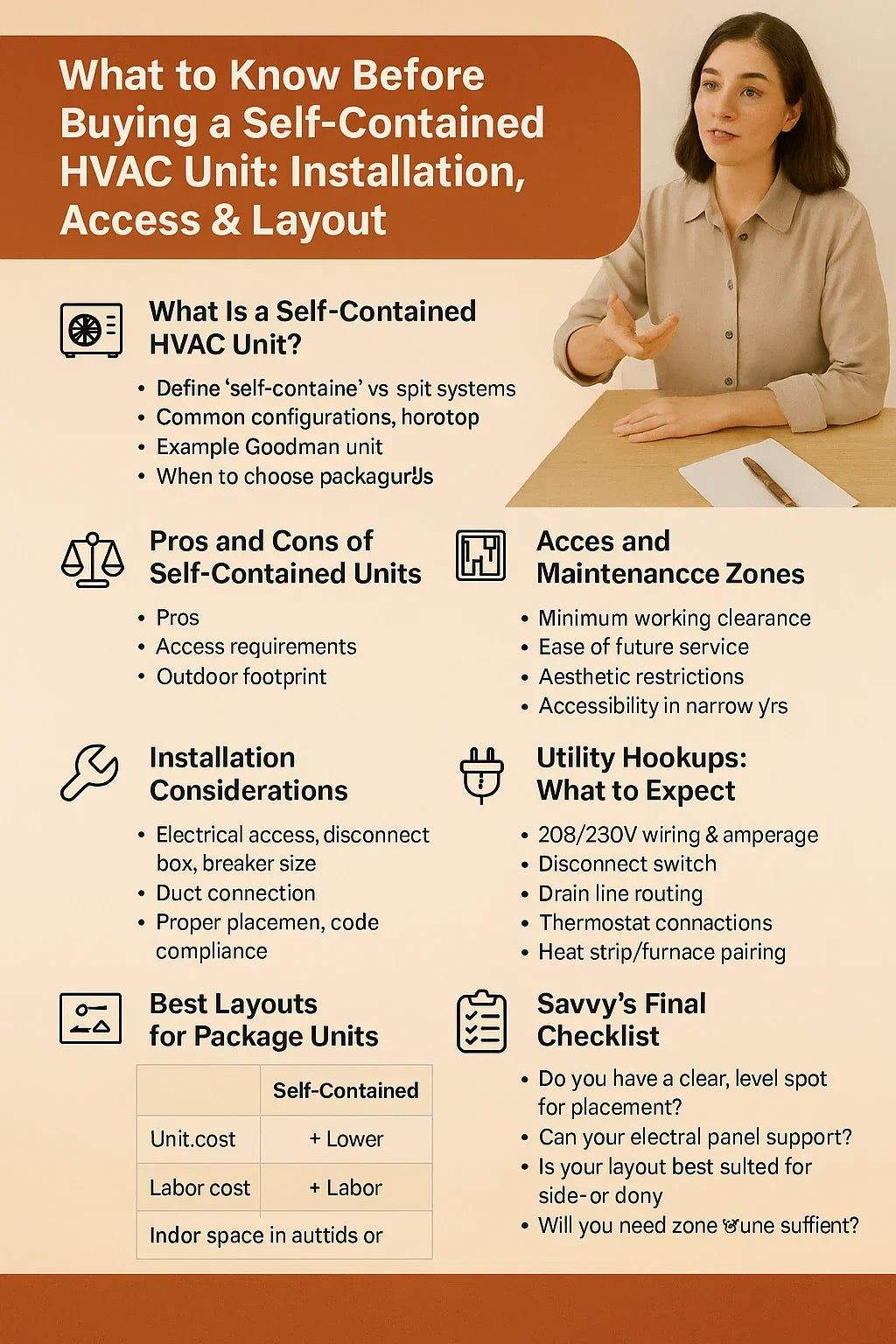Self-contained HVAC units, also known as packaged systems, are becoming increasingly popular for homeowners looking for a streamlined, space-efficient heating and cooling solution. But before you commit to one, it’s critical to understand what installation entails, what kind of access your home needs to provide, and how to optimize your layout for performance and efficiency.
This guide, tailored for Savvy homeowners, walks you through everything you need to know—from clearances to connections—before investing in a unit like the Goodman 2.5 Ton 13.4 SEER2 Self-Contained Horizontal Package AC.
🪩 What Is a Self-Contained HVAC Unit?
A self-contained HVAC unit houses all major heating and cooling components in one outdoor cabinet. This includes the compressor, condenser, evaporator coil, and fan.
Common configurations:
-
Horizontal discharge: Airflow exits side-to-side
-
Vertical discharge: Air exits the top
-
Gas/electric combos or heat pumps available
Best for:
-
Homes without basements
-
Slab-on-grade construction
-
Additions or retrofits
-
Mobile homes
Why it matters: Unlike split systems, packaged units simplify installation and reduce indoor equipment needs.
✅ Pros and Cons of Self-Contained HVAC Systems
✅ Advantages:
-
Compact, outdoor-only install
-
Shorter install time
-
Great for homes with limited indoor space
-
Precharged with refrigerant
⛔ Drawbacks:
-
Aesthetics: bulky outdoor footprint
-
Less zoning flexibility
-
May require duct modifications
Tip: Self-contained units are often more cost-effective for initial installs in smaller homes or add-on spaces.
📏 Site Requirements: Space, Slab & Clearance
Proper placement and clearance are critical for efficiency and code compliance.
👉 Minimum Clearance Requirements
Refer to Goodman’s installation manual:
-
Sides: 24" minimum
-
Front service access: 36" minimum
-
Back (wall-facing): 6" minimum
-
Above unit (vertical venting): 60" if applicable
🏠 Ground or Rooftop?
-
Ground-mount: Requires a level concrete pad
-
Rooftop: Needs proper curb, crane lift, and structural review
Verified Source: Goodman Packaged Unit Installation Manual
⚖️ Installation Considerations
Before purchasing a unit, ask yourself these key questions:
🔌 Electrical Access
-
Is a 208/230V power supply available?
-
Is there room for a disconnect box within sight?
-
Check amperage requirements on the nameplate.
🔧 Ducting
-
Does your ductwork match the unit’s horizontal or vertical airflow?
-
Are your ducts insulated and sealed?
💧 Drainage
-
Is there proper slope for condensate drainage?
-
Will rainwater runoff affect the unit location?
🚧 Permits & Code
-
Most municipalities require HVAC permits
-
Some HOAs restrict rooftop installs or visibility
Check local code: International Code Council
🚪 Access and Maintenance Zones
You or your HVAC technician will need to access the unit for maintenance, diagnostics, and repairs.
🛋️ Placement Tips:
-
Avoid placing against fences or walls that restrict airflow
-
Keep the unit on an accessible side of your property
-
Ensure snow and yard debris won’t accumulate
-
Allow ladder access if installed on a roof
Pro Insight: Units with horizontal airflow should not face common walkways or gathering areas due to warm air discharge.
📏 Best Layouts for Package Units
Packaged systems shine in certain layouts:
-
Slab-on-grade homes: Ground-mount at side or back
-
Mobile homes: Mounted on HVAC stand with underfloor duct connections
-
Room additions: Great for ductless areas needing new supply lines
-
Tiny homes or cabins: Compact units simplify retrofits
Helpful comparison: HVACDirect.com Packaged Units Guide
🧹 Split System vs Self-Contained Unit: A Comparison
| Feature | Packaged Unit | Split System |
|---|---|---|
| Install Time | Faster | Slower |
| Indoor Equipment | None | Required |
| Ideal Use | Retrofits, small homes | Zoned/multi-story homes |
| Cost | Lower | Higher |
| Maintenance Access | Outside only | Indoor & outdoor |
🔋 Utility Hookups: What to Expect
🔌 Electrical:
-
Typically 208/230V, 1-phase
-
Dedicated breaker required
🛠️ Thermostat Wiring:
-
24V wiring for cooling/heating control
-
Smart thermostat compatible in most cases
💧 Condensate Drain:
-
PVC line with slope
-
Optional condensate pump
Guide: Energy.gov HVAC Basics
📍 Layout Recommendations by Home Type
🏡 Mobile Homes
-
Side mount with stand
-
Duct connects under belly
🏚 Ranch-Style Homes
-
Rear corner placement
-
Horizontal airflow into attic or crawl ducts
🏠 Additions or Garages
-
Ideal for ductless spaces needing a retrofit
Extra Resource: Use AlpineHomeAir.com to compare sizes and airflow direction
📝 Final Checklist for Savvy Buyers
-
☑ Concrete or rooftop base ready?
-
☑ Sufficient clearance on all sides?
-
☑ Matching ductwork and airflow direction?
-
☑ Correct voltage and breaker in place?
-
☑ City permits/HOA approvals secured?
🚀 Ready to Take the Next Step?
Installing a self-contained HVAC unit isn’t just about choosing the right brand—it’s about prepping your home to maximize performance and longevity.
Stay Savvy and shop smart!
In the next topic we will read about: SEER2 Ratings Explained: Is 13.4 SEER2 Efficient Enough for Your Climate?







